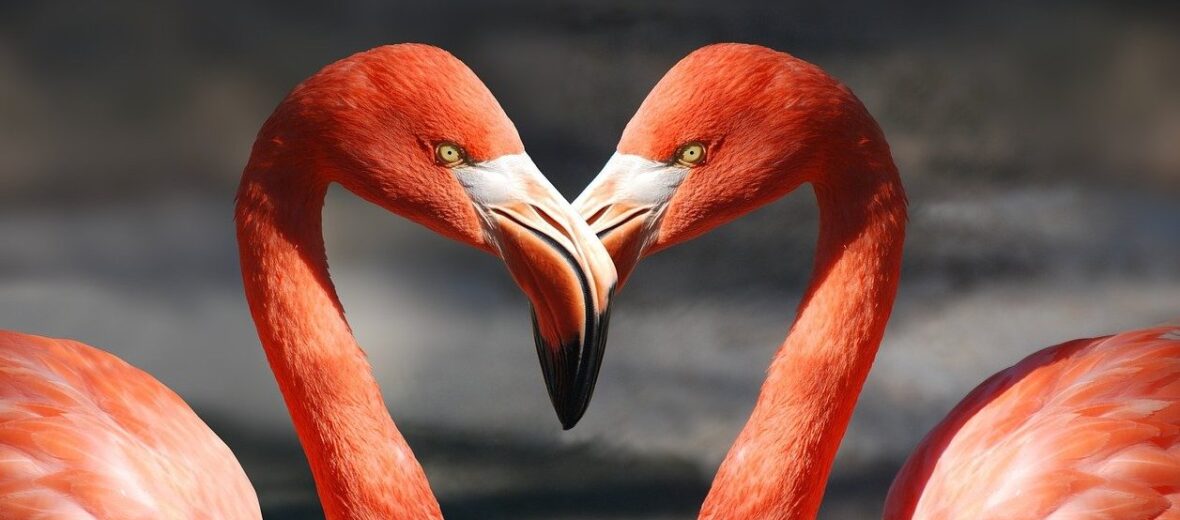
Made famous, in part, by plastic lawn ornaments it’s the flamingo. There are 6 known species of flamingo. Flamingos have good hearing but little to no sense of smell. Good thing, cause they can be a bit… messy, if you know what I mean. Did you know that, once they’re shed, flamingo feathers quickly lose their color and turn light pink to white. Also, the Andean flamingo is the only flamingo species with yellow legs. Most flamingo species are not endangered, although the Andean flamingo is listed as Vulnerable, and the Chilean, Lesser, and Puna flamingos are Near Threatened.
First the Stats…
Scientific name: Phoenicopterus
Weight: Up to 9 lbs.
Length: Up to 4.6 feet tall
Wingspan: Up to 5 feet
Lifespan: Up to 40 years
Now on to the Facts!
1.) A flamingo will spend up to 30% of the day preening their feathers. Oil produced in a special gland is spread over their feathers with the help of their beak.
2.) These birds love to congregate in large masses, called colonies. The colonies can contain up to a 1,000,000 birds!
3.) Both mom and dad incubate the egg. Several days after hatching, both parents will start feeding their chick with a milk-like substance (called crop-milk) which is rich in fats and proteins.
4.) Baby flamingos do not have a curved bill, it becomes curved a few months after birth.
5.) They eat shrimp, crustaceans, and algae.
But wait, there’s more on the flamingo!
6.) Flamingos eat by shuffling their feet in the mud and then take in a mouthful of muddy water and use specialized filters to sort out the mud and water, leaving behind the tasty meal.
7.) Being monogamous (mate for life) flamingos mate just once a year and this yields a single egg.
Did you know…?
Their pink color comes from the beta-carotene in the crustaceans and plankton that they eat. Without this, they slowly turn white.
8.) The nest is constructed out of mud.
9.) The visible ‘knee’ of a flamingo is actually their ankle joint. Their actual knee is close to the body and can’t be seen due to their feathers. So, when you wake up late at night wondering if flamingos have knees… yes they do. Now go back to sleep with this knowledge.
10.) Some flamingos like to steal a nest that’s already been built, so the mating pairs have to guard their nest from other flamingos as well as predators.
But wait, there’s still more on the flamingo!
11.) Flamingo chicks are born with grey and white feathers. They do not turn pink for a year or 2.
Did you know…?
Plastic lawn flamingos (Phoenicopterus plasticus) are an American cultural icon that was introduced in the 50s by artist Don Featherstone. This icon has grown so popular that in 2009, Madison, Wisconsin, named the plastic flamingo as the city’s official bird!
12.) Though the pink coloration is primarily seen in a flamingo’s plumage, the carotenoids they consume spread a lot deeper than just feathers. Flamingo skin is pink and even their blood is pink! Contrary to popular believe though, their egg yolks are not pink.
13.) Flamingo bullies exist. That’s right. They like to bully each other in order to establish hierarchy. They’ll even knock over a sleeping bird.
14.) Males and females perform a wonderful courtship dance to attract a partner.
15.) In South America, the Andean fox and Geoffrey’s cat prey on flamingos. In Africa, hyenas, lions, leopards, cheetahs, jackals, and even pythons attack them.
Now a Short Flamingo Video!
Also, check out the Critter Science YouTube channel. Videos added frequently!
Want to suggest a critter for me to write about? Let me know here.



